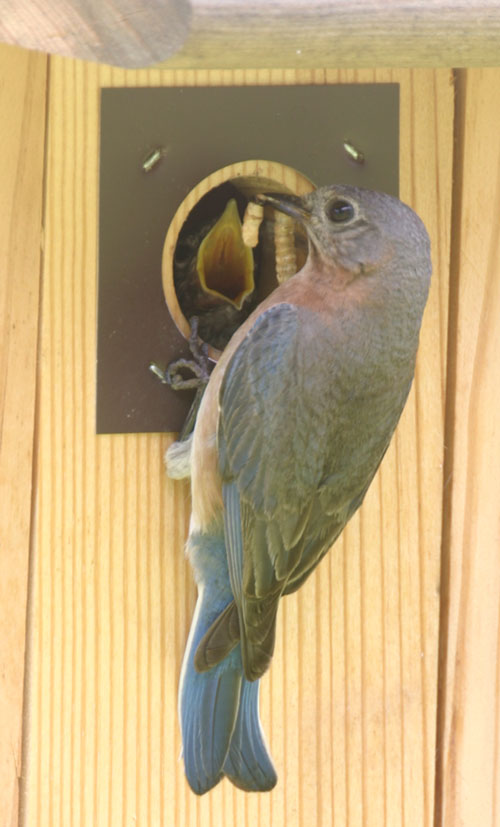 Sometimes you actually have some cooperation from your subjects, despite their best efforts. Mom paused for a nice profile, even allowing a view of her progenys’ meal, while one of the sprogs smiled (or something) for the camera in the opening of the nest box. It’s all because of clean living and pure thoughts.
Sometimes you actually have some cooperation from your subjects, despite their best efforts. Mom paused for a nice profile, even allowing a view of her progenys’ meal, while one of the sprogs smiled (or something) for the camera in the opening of the nest box. It’s all because of clean living and pure thoughts.
And, something that cannot quite be called a ‘camera trap.’ Typically, camera traps are configured so that they can be left all alone and the subject, the bird or clouded jaguar or whatever, triggers its own photo by breaking a light beam or infringing into the infra-red sensing area, making a sound or even simply bumping a switch. Such setups permit the photographer to be quite far away, perhaps asleep in bed, and thus the animals are not concerned about anyone’s presence. In my case here, however, the camera was simply rigged with a long extension on the shutter release, so I was broiling in the sun, watching for ideal moments from behind the pampas grass. Plenty of images have bad poses and motion blur, but I’m pleased with this one.
I mentioned the remote release before, at the bottom of this post; the inclusion of the 3.5mm connections between the remote and the two adapter ends made it easy to insert a 6.5 meter (20 ft) headphone extension cable – you know, from the old days when people had stereo systems. The eastern bluebirds (Sialia sialis) weren’t concerned about the presence of the camera close to the nest box, as long as I wasn’t too close.
The local wildlife has been a minor saga this spring. At about the time that the aforementioned red-shouldered hawk (Buteo lineatus) eggs should have been hatching, the mother abandoned the nest and did not return. I have no idea if something got to the eggs or they simply weren’t fertile, but there was never any sign of hatchlings. Both bluebird boxes that we erected this winter got early occupants, including a black-capped chickadee (Poecile atricapillus) who started a nest that got usurped by the bluebirds, but both nests became abandoned after five eggs each had been deposited.
Anyway, a second pair of bluebirds took over one of the nest boxes once I had removed the eggs from the first, and everything has been going smoothly so far. The young will be fledging soon, so I’m keeping my eyes open, not just for them, but for the neighborhood cats as well. And while I’m on the subject, I’ll mention something I should’ve months back. Fledgling birds rarely leave the nest with the ability to fly completely mastered, so people are constantly finding young birds that have “fallen from the nest” or are “injured and cannot fly away,” often considering them abandoned. But this is how they learn, by bailing the nest and developing their skills as they go, while the parents are nearby coaxing them along. You often don’t see the parents because they’ll stay well out of your range, to avoid drawing your attention to their young, while the young have the habit of freezing when danger threatens. If they have a complete covering of feather and at least short tail feathers, leave them be and watch from a distance – you will probably see one of the folks visit within half an hour.
So keep checking back, and we’ll see if I get any of the fledgling behavior, especially of the parents feeding them while they’re out of the nest.



















































